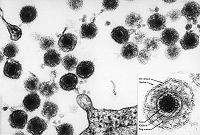Human T-lymphotropic virus
Articles that lack this notice, including many Eduzendium ones, welcome your collaboration! |
| Human T-lymphotropic virus | ||||||||
|---|---|---|---|---|---|---|---|---|
 | ||||||||
| Virus classification | ||||||||
|
Description and significance
Describe the appearance, habitat, etc. of the organism, and why it is important enough to have its genome sequenced. Describe how and where it was isolated. Include a picture or two (with sources) if you can find them.
Human T-lymphotropic virus was first discovered in Japan in 1977 as the first human retrovirus to be identified as such. It is thought to be the disease-causing agent in several ailments. Paraparesis is one disease thought to be caused by the virus where an individual's lower extremities are impaired. The virus is also thought to be an oncovirus, a cancer causing viral agent. Leukemia, a cancer of bone marrow or blood cells, has been linked to T-lymphotropic virus.
Genome structure
Describe the size and content of the genome. How many chromosomes? Circular or linear? Other interesting features? What is known about its sequence? Does it have any plasmids? Are they important to the organism's lifestyle?
The virus' genome consists of a single strand of RNA and uses reverse transcription to form DNA from an RNA template. Among retroviruses HTLV has a unique genome that leads to its unusual pathogenesis. It shares with other viruses the gag-pol-env motif with flanking LTR (long terminal repeat) sequences. It, however, includes a fourth sequence which acts in an ORF(open reading frame), and leads to products that are most likely pathogenic: Tax, Rex, p12, p13, and p30.
Cell structure and metabolism
Describe any interesting features and/or cell structures; how it gains energy; what important molecules it produces.
HTLV is an enveloped virus. A core contains the genetic material as well as reverse transcribing proteins that facilitate transcription from RNA to DNA. This core is encased in a protein shell called a capsid. The outer most portion of the virus is the envelope - a phospholipid bilayer derived from the host cell that helps the virus invade a host cell. Between the envelope and the capsid is a collection of proteins called the tegument.
Ecology
Describe any interactions with other organisms (included eukaryotes), contributions to the environment, effect on environment, etc.
HTLV interacts primarily with human hosts. Close relatives of the virus, however, do exist and invade other animal hosts.
Pathology
How does this organism cause disease? Human, animal, plant hosts? Virulence factors, as well as patient symptoms.
The virus, once in the host, can cause a variety of disease. These diseases include HTLV-1 associated myelopathy, opportunistic infections from other microbes due to a debilitated immune system, and cancer. In respect to debilitating the immune system, a unique feedback process involving Tax and Rex, an early and rapid replication of the virus is attained. This is followed by a sudden halt to viral replication. The quick replication and abrupt stop sequence allows for the virus to avoid host defenses. This places HTLV in the unique category of delta retroviruses, whose only other members are a few nonhuman viruses: BLV, STLV (simian T-cell leukemia virus), and PTLV (primate T-cell leukemia virus).
Application to Biotechnology
Does this organism produce any useful compounds or enzymes? What are they and how are they used?
Current Research
1. Project by The Nyborg Lab of Colorado State University is underway to explore the transciptional regulation of T-cells infected with HTLV. The goal is to study the interactions between the viral proteins, such as the Tax protein, and cellular machinery in vivo and in vitro. http://www.nyborglab.com/research.htm
2. Study being conducted at Fukuoka University is exploring alternatives to treating Adult T-Cell Leukemia/Lymphoma. Current usage of chemotherapy have insufficient results, but application of stem cell technology has yielded a possible new approach to treating the disease. http://www.ncbi.nlm.nih.gov/pubmed/18081707?ordinalpos=6&itool=EntrezSystem2.PEntrez.Pubmed.Pubmed_ResultsPanel.Pubmed_RVDocSum
3. Research on the role of nuclear factor-kappaB-inducing kinase using mice with a specific genotype. The study suggests that the lack of NIK inhibits HTLV replication and interrupts the maintenance of the provirus. http://www.ncbi.nlm.nih.gov/pubmed/18312467?ordinalpos=3&itool=EntrezSystem2.PEntrez.Pubmed.Pubmed_ResultsPanel.Pubmed_RVDocSum
References
1. http://en.wikipedia.org/wiki/Human_T-lymphotropic_virus
2. http://www.medicalnewstoday.com/articles/95706.php
3. http://www.ncbi.nlm.nih.gov/pubmed/
4. http://www.emedicine.com/med/topic1038.htm
5. http://www.nyborglab.com/research.htm